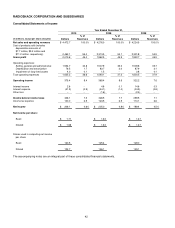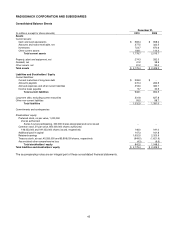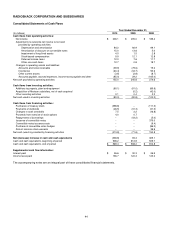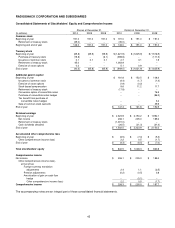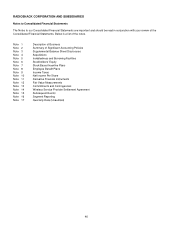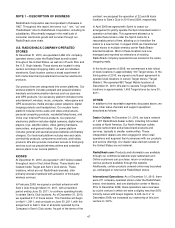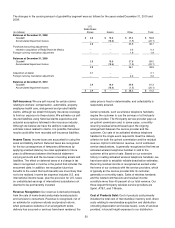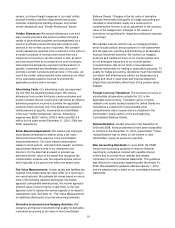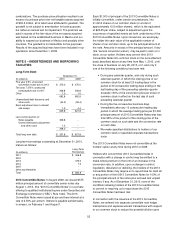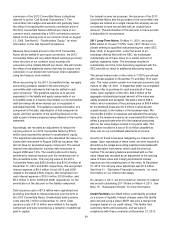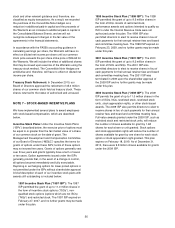Radio Shack 2010 Annual Report Download - page 59
Download and view the complete annual report
Please find page 59 of the 2010 Radio Shack annual report below. You can navigate through the pages in the report by either clicking on the pages listed below, or by using the keyword search tool below to find specific information within the annual report.49
products. If the calculated net realizable value of the
inventory is determined to be less than the recorded cost, a
provision is made to reduce the carrying amount of the
inventory.
Property, Plant and Equipment: We state our property,
plant and equipment at cost, less accumulated depreciation
and amortization. Depreciation and amortization are
calculated using the straight-line method over the following
useful lives: 10-40 years for buildings; 2-15 years for
furniture, fixtures, equipment and software; leasehold
improvements are amortized over the shorter of the terms
of the underlying leases, including certain renewal periods,
or the estimated useful lives of the improvements. Major
additions and betterments that substantially extend the
useful life of an asset are capitalized and depreciated.
Expenditures for normal maintenance and repairs are
charged directly to expense as incurred.
Capitalized Software Costs: We capitalize qualifying
costs related to the acquisition or development of internal-
use software. Capitalization of costs begins after the
conceptual formulation stage has been completed.
Capitalized costs are amortized over the estimated useful
life of the software, which ranges between three and five
years. The unamortized balance of capitalized software
costs at December 31, 2010 and 2009, was $55.3 million
and $46.6 million, respectively. Amortization of computer
software was approximately $11.9 million, $15.1 million and
$21.1 million in 2010, 2009 and 2008, respectively.
Impairment of Long-Lived Assets: We review long-lived
assets (primarily property, plant and equipment) held and
used, or to be disposed of, for impairment whenever events
or changes in circumstances indicate that the net book
value of the asset may not be recoverable. Recoverability is
assessed based on estimated undiscounted cash flows
from the useful asset. If the carrying amount of an asset is
not recoverable, we recognize an impairment loss equal to
the amount by which the carrying amount exceeds fair
value. We estimate fair value based on projected future
discounted cash flows. Our policy is to evaluate long-lived
assets for impairment at a store level for retail operations.
Leases: For lease agreements that provide for escalating
rent payments or free-rent occupancy periods, we
recognize rent expense on a straight-line basis over the
non-cancelable lease term and certain option renewal
periods that appear to be reasonably assured at the
inception of the lease term. The lease term commences on
the date we take possession of or control the physical use
of the property. Deferred rent is included in other current
liabilities in the Consolidated Balance Sheets.
Goodwill and Intangible Assets: Goodwill represents the
excess of the purchase price over the fair value of net
assets acquired. Goodwill and intangible assets with
indefinite useful lives are reviewed at least annually for
impairment (and in interim periods if certain events occur
indicating that the carrying value of goodwill and intangible
assets may be impaired). We estimate fair values utilizing
valuation methods such as discounted cash flows and
comparable market valuations. We have elected the fourth
quarter to complete our annual goodwill impairment test. As
a result of the fourth quarter impairment analyses, we
determined that no impairment charges to goodwill were
required.





